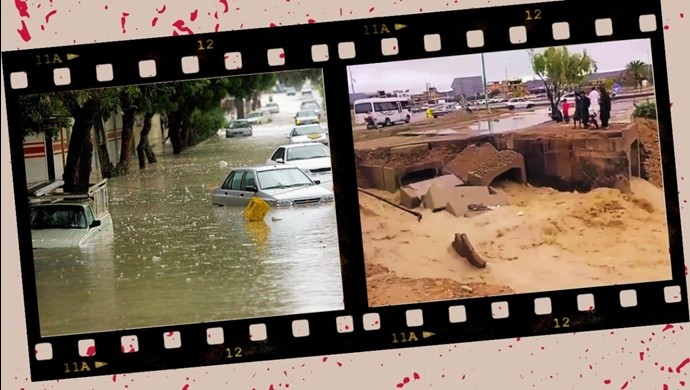
In the past few days, the provinces of Bushehr, Khorasan Razavi, South Khorasan, Sistan and Baluchestan, Fars, Kerman, Hormozgan, and Yazd have been affected by floods and inundation, and many people have lost their lives and livelihoods.
Thousands of compatriots are displaced, homeless, affected by floods, and seeking refuge in flood-affected areas. Communication routes are closed, power lines have collapsed, agricultural lands have been destroyed, and it is difficult for relief efforts to reach the affected people. What’s worse is that the people of Sistan and Baluchestan have experienced house-destroying floods in less than two months, submerging their remaining belongings. The floods have affected hundreds of villages and blocked communication routes. There is no clean water to drink and no electricity to use.
The most damaged area is Zarabad, which is completely submerged. On April 20, the state-run Ham-Mihan newspaper reported, “Zarabad is the center of Makran Development, but it doesn’t even have the smallest machinery or equipment, not even a high-clearance road maintenance vehicle that can reach the villages itself.”
On April 20, Fararu news website quoted a citizen of Zarabad as saying, “One of the main reasons for these floods is the mismanagement of water flow and the neglect of river dredging. The consultants for road construction projects do not use the local knowledge of the people at all, and they pay no attention to their warnings. As a result, most bridges have collapsed, and all agricultural lands and people’s homes have been submerged… After the flood, the Minister of Interior visited this area, but what good did it do? When there is no machinery like a tractor in the road maintenance department, what can that road maintenance facility and crisis team do?”
The cities of Konarak, Chabahar, and Dashtiari are facing a similar situation, as they have also suffered extensive damage from the floods in February. The greater tragedy here is that even a water tanker is not available at the scene. It is not possible to use local resources such as front-loaders and compressors because the government, under Regime president Ebrahim Raisi, does not provide them with the necessary fuel.
For years, in the Dashtiari region, deep channels called “Gorgroks” have been created, and with each flood, their depth increases, drawing and exacerbating the flow of water. This multiplies the severity of heavy rainfall crises several times over. As a result, agricultural lands are destroyed, and mud and brick houses collapse. On May 12, 2020, the ILNA news agency reported, “The area affected by the erosion caused by the Gorgrok, according to statistics from the Department of Natural Resources and Watershed Management, covers an area of 800,000 hectares, located 70 kilometers northeast of Chabahar city.”

MEK Iran (follow us on Twitter and Facebook), Maryam Rajavi’s on her site, Twitter & Facebook, NCRI (Twitter & Facebook), and People’s Mojahedin Organization of Iran – MEK IRAN – YouTu
